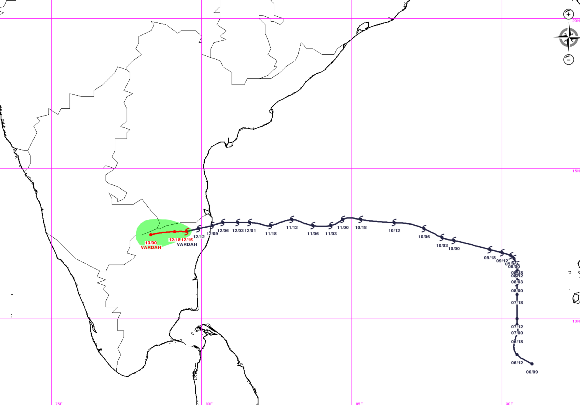Cyclone Vardah
Status: Closed
| Type of posting | Posting date(EST): | Summary | Downloads |
|---|---|---|---|
| Landfall | 12/12/2016 11:30:00 AM |
|
Landfall | Summary
Posting Date: December 12, 2016, 11:30:00 AM
Very Severe Cyclone Vardah made landfall near the Indian city of Chennai, the capital of Tamil Nadu state, on Monday, December 12, 2016, between 15:00 and 17:00 IST (9:30-11:30 UTC). With wind speeds as high as 100-110 km/h (62-68 mph) reported, and drenching rain, Vardah has caused wind damage to lightly built structures and some localized flooding as it moved across the northern part of Tamil Nadu. The National Disaster Management Authority reported four deaths from the cyclone.
Cyclone Vardah—which originated as a tropical disturbance on December 6—is the only storm to have attained very severe cyclonic storm status in the Bay of Bengal this year. While still a depression over the Bay of Bengal, Vardah brought heavy rainfall to the Andaman Islands, from which 2,300 tourists were evacuated.

Cyclone Vardah track map as of 20:30 IST (15:00 UTC) on December 12, 2016. (Source: IMD)
Damage and Disruption
The India Meteorological Department (IMD) issued a heavy rainfall warning and a wind warning prior to landfall, and reportedly tens of thousands of people were evacuated, including many from low-lying areas.
The IMD projected wind speeds of 70-80 km/h (43-50 mph), with gusts to 90 km/h (56 mph) for the first few hours after landfall, with some damage to power and communications lines due to uprooted trees and broken branches, and roof damage to thatched huts. Heavy rainfall was expected throughout the region, with heavy to very heavy precipitation in southern coastal Andhra Pradesh, Rayalaseema, northern Tamil Nadu, and Puducherry, according to the IMD. Damage to roads in Kutcha and Pucca also was expected, as well as to paddy crops and to banana and papaya trees and orchards.
Reported damage includes windows blown out of high-rise buildings in Chennai and some power outages.
Flight operations were suspended at the Chennai airport because of strong winds, runway flooding, and dismal visibility, and a number of flights were diverted to Hyderabad and Bangalore airports. Train service also was impacted, both regional and local. Offices and schools and colleges in Chennai, Kanchipuram, and Tiruvallur were closed for Monday and Tuesday.
Fishermen were advised not to go to sea while the sea remained high, although conditions should moderate by Tuesday morning.
Exposure at Risk
Historically, the dominant construction type in India has been unreinforced masonry, which is still pervasive throughout rural India in low- and mid-rise residential and commercial structures. Increasingly, however, modern urban buildings in India are employing more durable construction types, such as confined masonry and reinforced concrete. Moreover, these buildings are incorporating advanced features in their design and are subject to better construction practices and stricter code enforcement. This is particularly true of new high-rise buildings, which are generally made of reinforced concrete.
Extensive damage from Cyclone Vardah is expected to poorly constructed homes, including to mud and thatched roof structures common in fishing villages along India’s eastern coast.
Insurance Impact
While mud and thatched roof structures are certainly uninsured, personal property is not adequately insured even in urban areas. Crops are likewise largely uninsured. In contrast, industrial risks, including energy, oil, and gas plants in the affected region, are well insured against natural disasters.
Forecast Track and Intensity
The IMD forecast Cyclone Vardah to move nearly westward across Tamil Nadu, weakening by Tuesday, December 13, to a depression, with maximum sustained surface wind speeds of 35-45 km/h (22-28 mph) and gusts to 55 km/h (34).